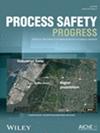核燃料循环设施中氨储存装置的风险和后果分析
IF 1
4区 工程技术
Q4 ENGINEERING, CHEMICAL
引用次数: 0
摘要
工业灾难,如意外释放有毒气体导致火灾、爆炸和人员死亡,正在破坏全球生态环境和相关技术的社会认可度。风险和后果分析是保护环境和人类生命的工艺安全措施的关键特征。在这项工作中,对位于核燃料循环设施内的一个储罐意外释放无水液氨的风险和后果进行了分析,以确定泄漏是否会导致周围人群暴露和火灾以及相关的热辐射风险。风险评估采用四种方法进行:据观察,虽然故障树分析、Probit 分析和 ALOHA 预测的危害严重程度几乎趋于一致,但传统的 F&EI(化工行业的安全主力)估计的相应危害数值较低。针对化工厂位于核设施内的情况,提出了一种加载一般 F&EI 值的方法。过载的 F&EI 程序估算出了氨意外释放的危险值,与 FTA、Probit 和 ALOHA 分析的结果非常吻合。本文章由计算机程序翻译,如有差异,请以英文原文为准。
Risk and consequence analysis of ammonia storage units in a nuclear fuel cycle facility
Industrial disasters, such as unintended toxic gas releases resulting in fires, explosion, and fatalities, are damaging both the global ecology and the social acceptance of the related technology. Risk and consequence analysis is the key feature of process safety measures for the protection of environment and human life. In this work, the risk and consequence analysis of unintended release of anhydrous liquid ammonia for one of the storage tanks, located inside the nuclear fuel cycle facility, was analyzed for leakages leading to exposure of surrounding human population and fire with allied thermal radiation risk. The risk assessment was performed using four methods: Fault tree, E&FI methodology, Probit, and ALOHA, It was observed that while the predicted hazard severities from fault‐tree analysis, Probit analysis, and ALOHA nearly converged, the conventional F&EI, the safety workhorse of the chemical industry estimated low numeric values of the respective hazard. A methodology was proposed to load this general F&EI value for the case of chemical plant being located inside a nuclear facility. Overloaded F&EI procedure estimated hazard value for envisaged unintended ammonia release in good agreement, with results from FTA, Probit, and ALOHA analyses.
求助全文
通过发布文献求助,成功后即可免费获取论文全文。
去求助
来源期刊

Process Safety Progress
工程技术-工程:化工
CiteScore
2.20
自引率
10.00%
发文量
99
审稿时长
6-12 weeks
期刊介绍:
Process Safety Progress covers process safety for engineering professionals. It addresses such topics as incident investigations/case histories, hazardous chemicals management, hazardous leaks prevention, risk assessment, process hazards evaluation, industrial hygiene, fire and explosion analysis, preventive maintenance, vapor cloud dispersion, and regulatory compliance, training, education, and other areas in process safety and loss prevention, including emerging concerns like plant and/or process security. Papers from the annual Loss Prevention Symposium and other AIChE safety conferences are automatically considered for publication, but unsolicited papers, particularly those addressing process safety issues in emerging technologies and industries are encouraged and evaluated equally.
 求助内容:
求助内容: 应助结果提醒方式:
应助结果提醒方式:


